| |
|
|
| |
|
|
| |
|
|
| |
|
|
| |
|
|
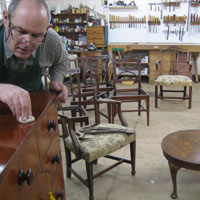
Customer Reviews
""I am really pleased with the desk you did.
It looks great"
Diana B.- Winchester - 05/10/2012 |
|
| |
|
|
| |
| An early 19th century carved
and water gilded looking glass |
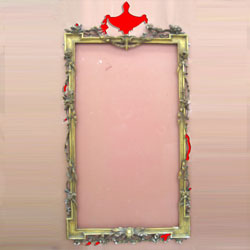 |
An
early 19th century carved gilded mirror missing its
focal ornament. After extensive research and digital
prototyping a replacement classical urn was carved from
lime wood



|
|
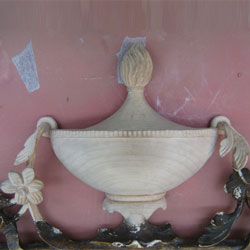 |
| |
|
|
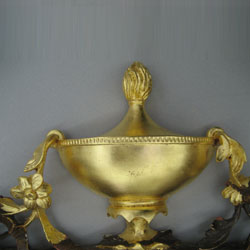 |
The
replacement sections were water gilded in the traditional
manner before toning in to match the existing gilding
scheme. |



|
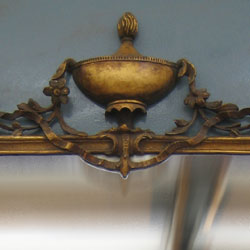 |
|
| An early 19th century marble
specimen table |
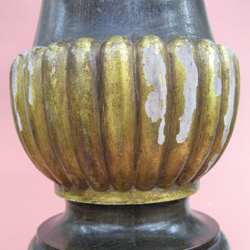 |
The
Damaged gilding usually represents a larger area of
loose or cleaved gesso.
New gesso is built up as on the right, around 15 coats
for this project.


|
|
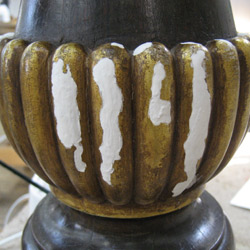 |
| |
|
|
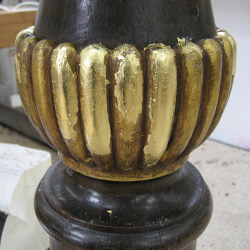 |
The
replacement gilding here was 23.25ct gold leaf carefully
matched to the original gilding, applied in the traditional
manner.
Finally the new gilding is toned in to match the original
surface using a protective size coat. |


|
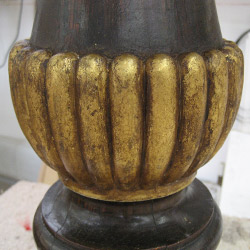 |
|
| A Regency convex mirror |
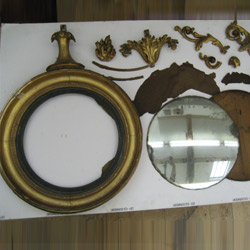 |
This
badly damaged regency convex mirror had structural damage
as well as lost and over painted gilding
The fragile and detached areas were consolidated and
carefully reattached using Isinglass injected under
the lifted areas.


|
|
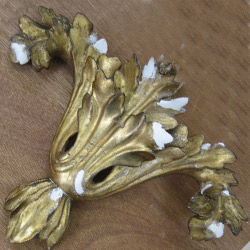 |
| |
|
|
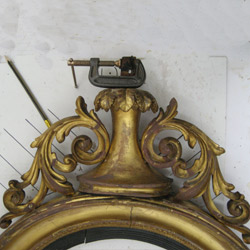 |
Final
frame repairs are done before the new carefully colour
matched bole is applied.
The replacement gilding here was 23.25ct gold leaf
carefully matched to the original gilding, applied in
the traditional manner.


|
|
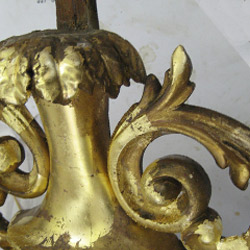 |
| |
|
|
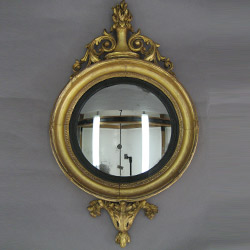 |
| Finally
the new gilding is toned in to match the original surface
and highlights burnished on the water gilded areas.
A protective coat of micro-crystalline wax completes
the treatment.


|
|
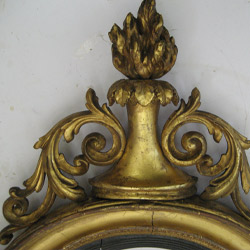 |
|
| A late 18th century satinwood
cased white dial clock |
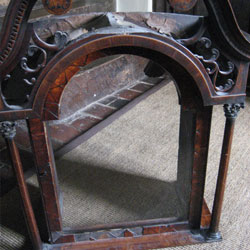 |
This
unusual clock had been stored innapropriately for many
years. A full restoration to the case and movement were
necessary to return the clock to working order.



|
|
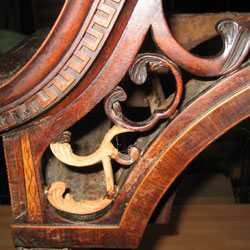 |
| |
|
|
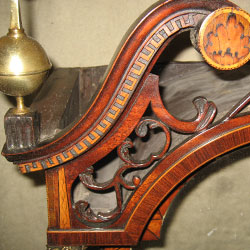 |
|
The replacement carving was matched with the original,
and many missing sections of banding had to be hand
cut from the solid.



|
|
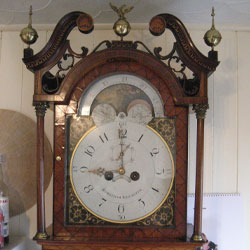 |
|
| An early 18th century Boulle
marquetry clock and bracket |
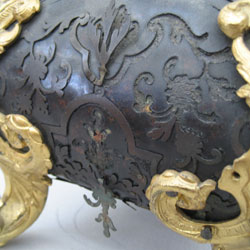 |
This
Boulle style clock case required extensive restoration.
Approximately 25% of the brass and 10% of the turtle-shell
was missing. The remaining marquetry needed removing
to stabilise the substrate



|
|
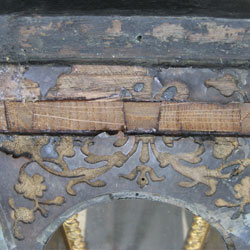 |
| |
|
|
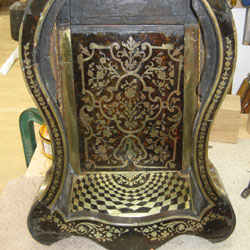 |
The
ormolu mounts carried a duty stamp for 1740 allowing
accurate dating. Working alongside a clock conservator
and with specialist restoration to the enamel dial the
treatment was a great success |



|
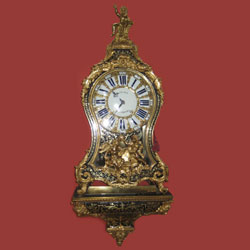 |
|
| An early 19th century Dutch
Marqutry folding card table |
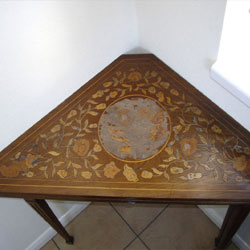 |
This
early 19th century Dutch Marquetry folding card table
was missing its central motif, the remaining marquetry
needed localised consolidation.
After planning the new roundel by research and digital
prototyping the new panel was cut, glued onto paper
and fitted.


|
|
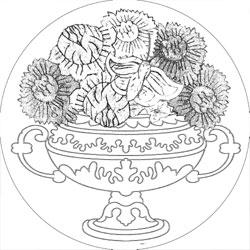 |
| |
|
|
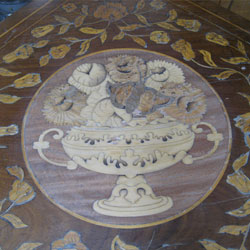 |
The
new panel needed careful colouring and polishing followed
by a good quality wax finish to help protect the top
from future damage. |



|
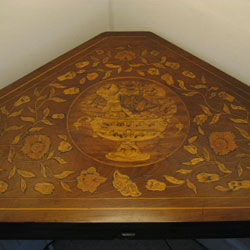 |
|
| An important Late 18th century
Japanned clock by Claude du Chesne |
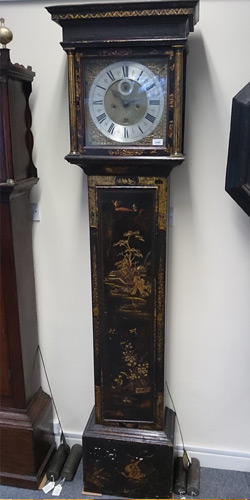 |
This
late 18th century Lacquered Longcase clock was from
the workshops of Claude du Chesne, an Important Hugenot
clock maker with examples of his work in the Victoria
and Albert museum.

The case needed a full restoration as
the Japanned finish was lost on the sides and badly
damaged on the front. The base of the trunk was lost
completely. |
|
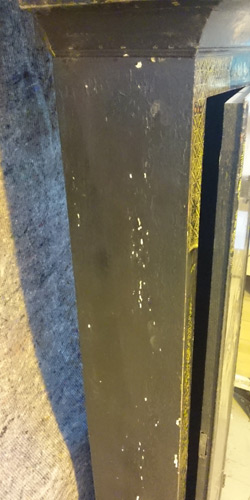 |
| |
|
|
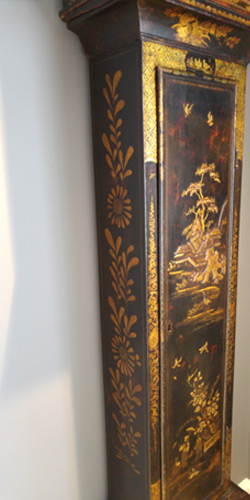 |
The
new Japanning needed careful matching and toning of
the gold leaf to match the original work, followed by
a good quality wax finish to help protect the surface
from future damage. |

The
Japanning of the sides were reproduced from existing
examples and the design is based on stylised chrysanthemums,
a popular chioiserie motif. |
|
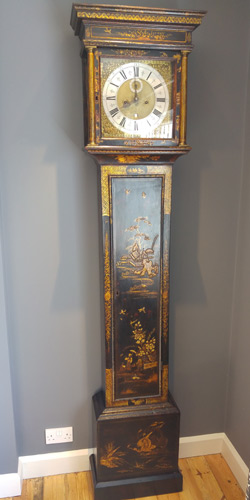 |
|
| An important Late 17th century
Italian marriage cassonne |
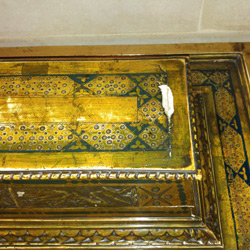 |
This
important late 17th century marriage cassonne had suffered
damage to it's cut gesso and polychrome decoration.

The damaged area was isolated using a
reversible barrier coat before restoration began |
|
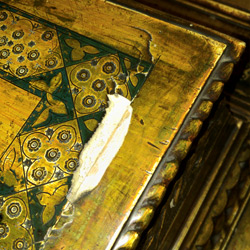 |
| |
|
|
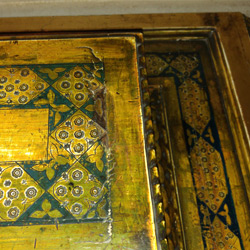 |
The
new gesso was applied and allowed to cure before cutting
in the design in the traditional manner.

Finally th epolychrome decoration was reproduced to
complete the conservation treatment |
|
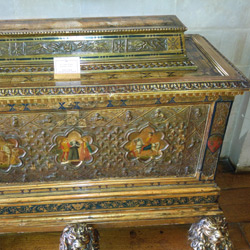 |
|
| A 17th century pilgrims model
of the Basilica of the Holy Sepulchre |
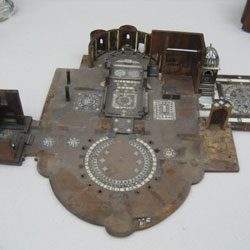 |
This
heavily damaged Olive-wood pilgrims model required extensive
structural repair and replacement of missing mother
of pearl sections.



|
|
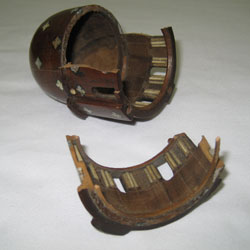 |
| |
|
|
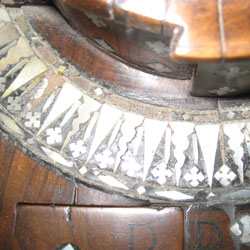 |
Ivory
sections were replaced using cast epoxy resins and the
full treatment is entirely reversible |



|
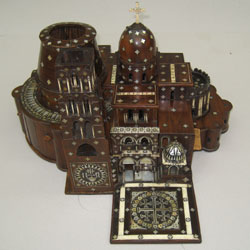 |
|
| A Regency work table |
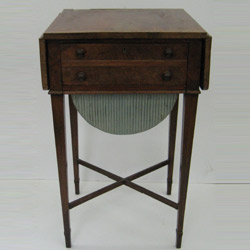 |
| This
regency work table had been altered around 100 years ago
with the marriage of straight tapering legs. These were
removed to allow consolidation of the remaining carcass. |


|
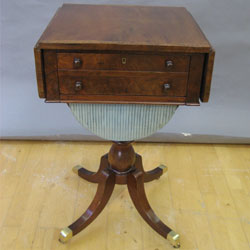 |
| |
|
|
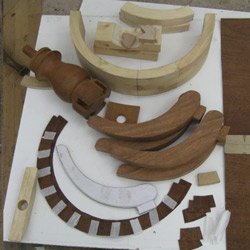 |
| New
components were constructed from period timber in the
traditional nineteenth century manner. |


|
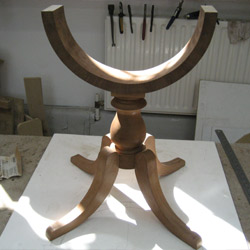 |
| |
|
|
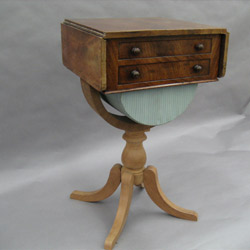 |
| After
repairing the top and replacing missing cross banding
the new components were attached and coloured in to match
the original. |


|
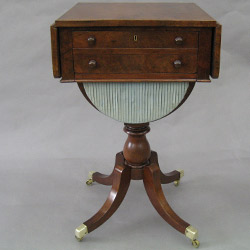 |
|
| A coaching table |
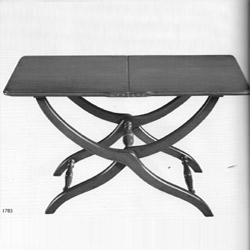 |
| This
pretty folding mahogany coaching table was reproduced
from a photograph, as you can see some alterations were
made to the original dimensions and design by adding a
bespoke brass arrow detail and a handmade brass catch. |


|
 |
|
| A 19th century satinwood elbow
chair |
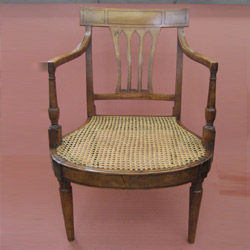 |
| This
chair was missing all 4 feet along with various splits
and damaged caning. New feet were turned using Satin Birch,
the splits were all consolidated and the chair re-caned. |


|
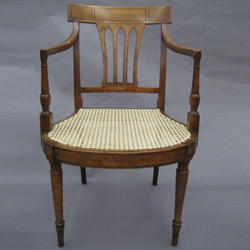 |
|
| An 18th century walnut fauteuil |
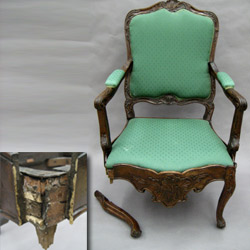 |
A
difficult break in this walnut fauteuil was carefully
built up using 7 different splices of old walnut to
provide an almost invisible and very strong repair.
FTIR was used to establish repair history and allow
controlled reversibility. |


|
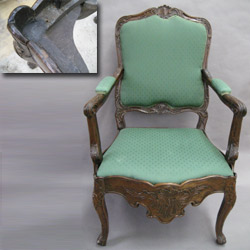 |
|
| A 17th century Italian chair |
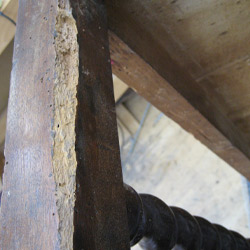 |
| This
rare late 17th century chair had suffered extensive common
furniture beetle damage. After treating the infestation
the damaged timber was consolidated and the missing area
reconstructed by epoxy casting over japanese tissue. |


|
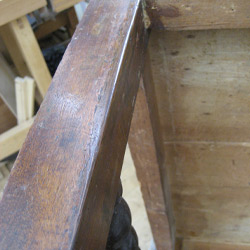 |
|
|
|
|
| |
| 12 Seater Dining table
& Chairs |
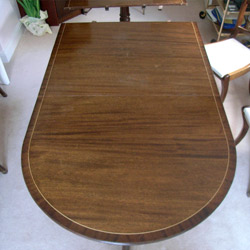 |
The
Damaged lacquer on this dining table was repaired
before new lacquer was applied to bring up the
finish. |
|
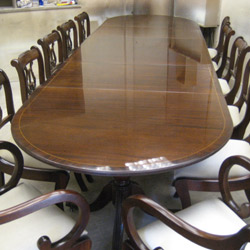 |
|
| Marble Specimen table |
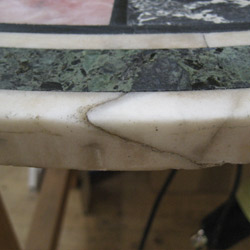 |
| This
Pietre Dure table had a structural crack that was
also unsightly. After treatment the marble was cleaned
and treated with a protective wax. |
|
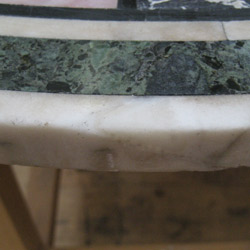 |
|
| Early 18th century Walnut
chest |
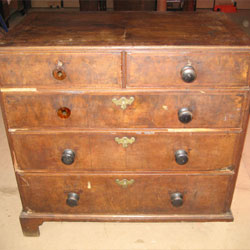 |
This
early 18th century Walnut chest had suffered extensive
woodworm damage and neglect, but was 90% complete.
After careful reconstruction of the damage done
by fitting knobs the piece was french polished
and waxed. |
|
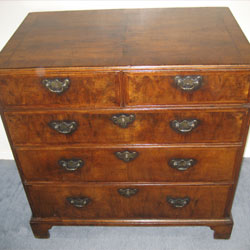 |
|
| Victorian Circular Pot
Cupboard |
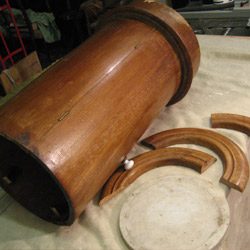 |
A
Victorain Pot Cupboard having suffered extensive
woodworm damage and neglect, but 99% complete.
After Careful re-gluing and doweling of the ring,
some minor veneer repairs the piece was french
polished and waxed. |
|
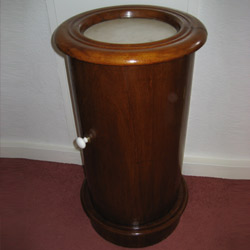 |
|
| Victorian Writing table |
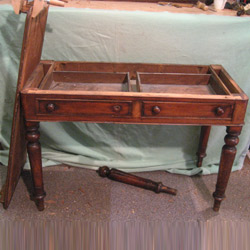 |
| This
late Victorian Writing table had suffered badly
from watermarking. Approximately 50% of the mouldings
were misiing and there was extensive structural
damage. After French polishing the colour of the
timber can be fully appreciated. |
|
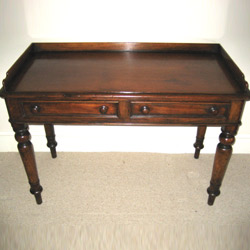 |
|
| George II Toilet Mirror |
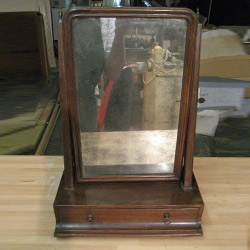 |
A
super George II toilet mirror, missing its ogee
feet.
After fitting the replacement feet and some minor
veneer repairs the piece was cleaned and waxed. |
|
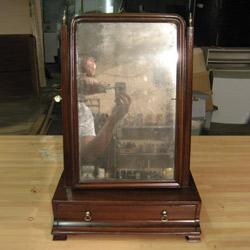 |
|
| Victorian Windsor Chair |
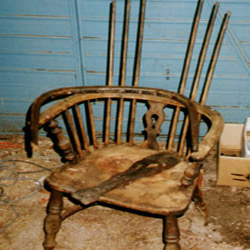 |
| A
super ash elm and yew windsor chair, apart from
the structural damage all it needed was a clean
and wax polish. |
|
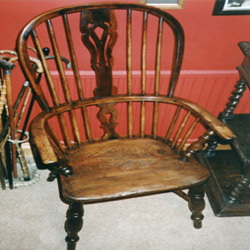 |
|
| Edwardian Jardiniere |
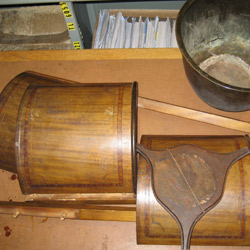 |
| This
jardiniere, was in a pretty bad way, after repairs
and removal of the de-natured polish, the the colour
shows through. |
|
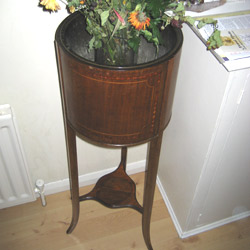 |
|
| Victorian Grandad Chair |
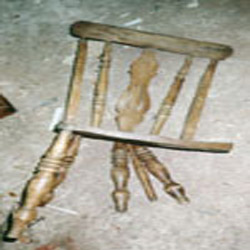 |
| This
chair was missing two stretchers and both arms when
it arrived at the workshops. A full refinish was
required to bring it back to life. |
|
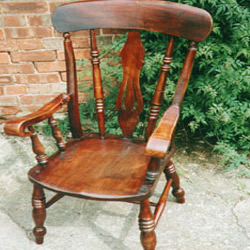 |
|
| George III Side Table |
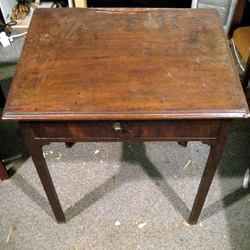 |
| A
rare George III side table missing a large section
of veneer at the back of the table top, and requiring
a bespoke brass swan neck handle. |
|
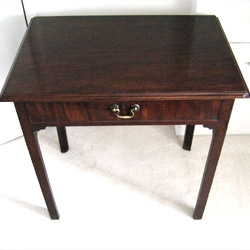 |
|
| George III Bureau |
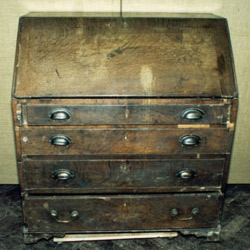 |
| A
George III oak bureau requiring total restoration
including brasses, spliced repairs to the bracket
feet and replacement of missing mahogany crossbanding.
|
|
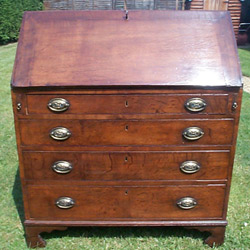 |
|
| George III Bureau (Interior) |
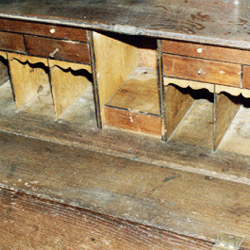 |
| The
new central door was made from period timber, the
veneer for the star was handcut from holly and ebony
and the knobs were turned from ivory on the lathe. |
|
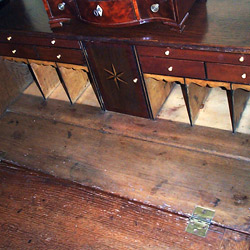 |
|
| Set of Six Victorian
Dining Chairs |
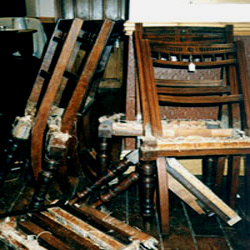 |
| The
frames had suffered woodworm damage - after removal
of the infested timber, the frames were upholstered
in a fabric of the clients choice. |
|
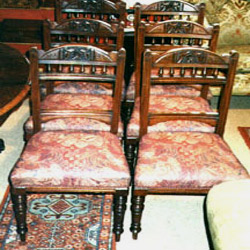 |
|
| Balloon-back Dining
Chair |
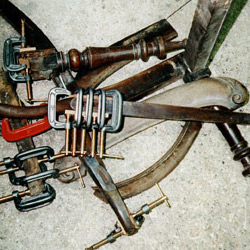 |
| This
balloon-back chair needed extensive frame repairs
before using an old leather to complete the re-upholstery. |
|
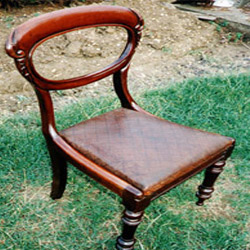 |
|
| Victorian Bonheur Du
Jour |
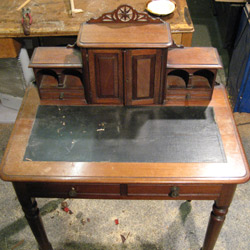 |
| An
attractive Victorian bonheur du jour needing a replacement
hinge, a professional clean and a new leather. |
|
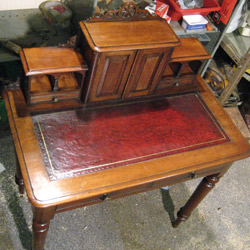 |
|
| Mid 18th Century Oak
Mule Chest |
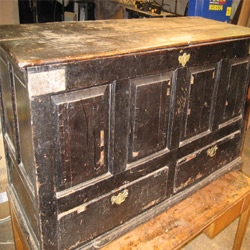 |
| A
rather dilapidated George II oak mule chest retaining
its original brass. A wonderful colour had survived
beautifully underneath the many layers of discoloured
Victorian varnish. |
|
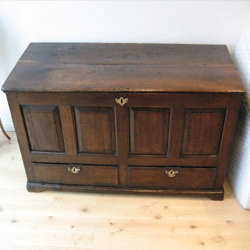 |
|
| Georgian supper table |
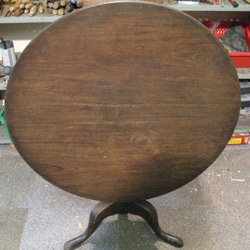 |
| A
georgian supper table in for a clean. As you can
see under the grime was a beautiful original patina. |
|
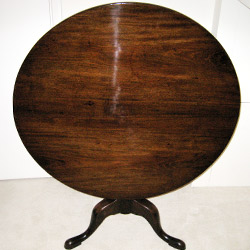 |
|
| Edwardian Writing Desk |
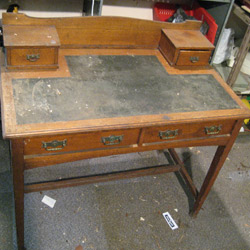 |
| An
arts and crafts influenced writing desk missing
a section of moulding and in for a clean. |
|
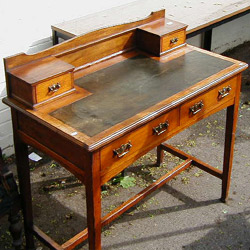 |
|
| Early Victorian tea
table |
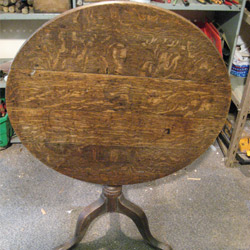 |
| An
early Victorian tea table needing a good a clean
and some re-polishing to the top. |
|
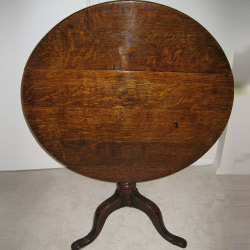 |
|
An18th century Mahogany
kneehole desk |
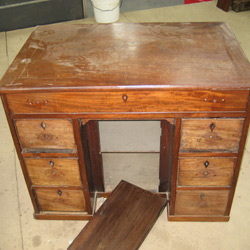 |
This
heavily damaged desk had been in the hands of
an amateur restorer, it was missing its feet and
signicant other parts



|
|
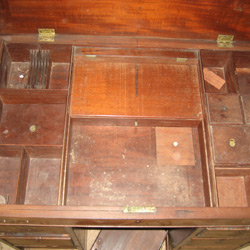 |
| |
|
|
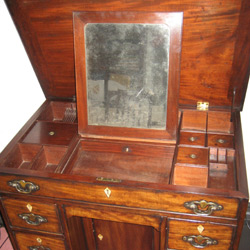 |
The
original 18th century silvered mirror looked good
back in place, as did the handmade ivory escutcheons
|



|
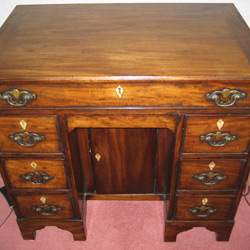 |
|
| Walnut serpentine desk |
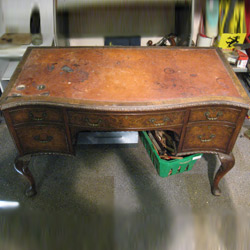 |
The
Damaged leather on this desk was carefully removed
before a new skiver was applied and gold tooled
to match the original pattern. |
|
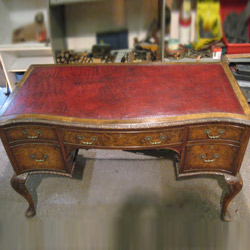 |
|
| Walnut Davenport |
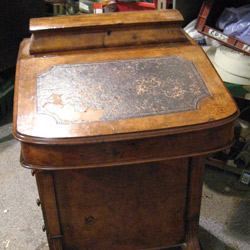 |
The
Damaged leather on this davenport was a carefully
matched skiver to the desk above, it was applied
and tooled in black to match the original pattern. |
|
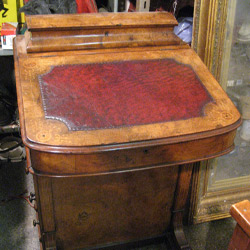 |
|
| Georgian Pot Cupboard |
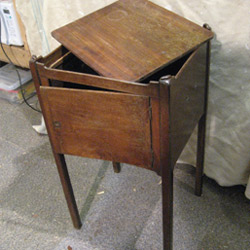 |
| This
George III pot cupboard needed the de-natured polish
carefully removing before a full re-polish restored
it to its former glory. The reproduction brass fittings
complete the job. |
|
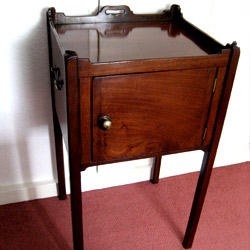 |
|
| William IV Wot Not |
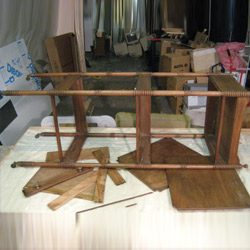 |
| This
William IV Wot Not needed some structural repairs
and some black rings and scratches removing before
a full re-polish restored it to its original condition.
|
|
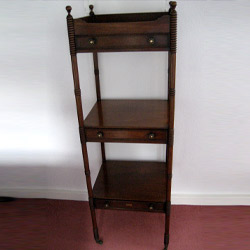 |
|
| Victorian Bow-front
Chest of Drawers |
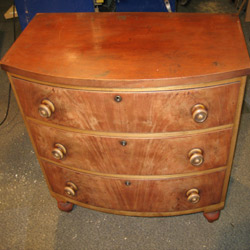 |
| This
Victorian country bow-front chest of drawers needed
the de-natured polish carefully removing before
a full re-polish restored it to its former glory. |
|
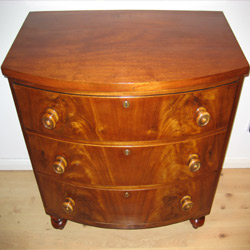 |
|
| Victorian Breakfast
Table |
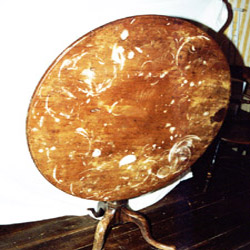 |
| This
Victorian breakfast table with a massive one-plank
top was in wonderful condition underneath the damaged
polish. |
|
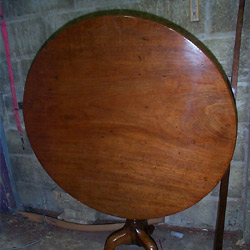 |
|
| Regency Writing Desk |
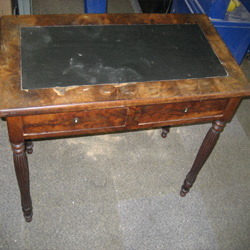 |
| This
late George III writing desk was missing veneer,
and needed to have the 1930's leatherette removed
and replaced with the original leather skiver. |
|
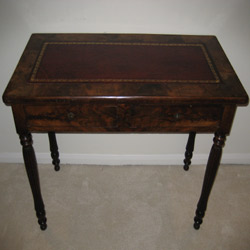 |
|
| Victorian Walnut tea
table |
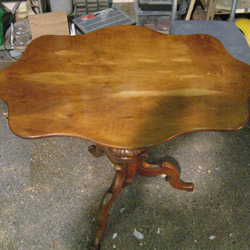 |
| This
late Victorian tea table had suffered badly from
watermarking. After a full re-polish the beauty
of the timber really shows through. |
|
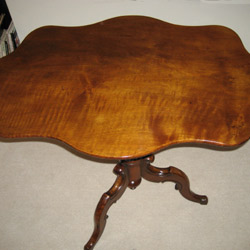 |
|
| Victorian Ladies Desk |
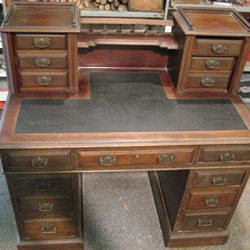 |
| After
replacing the drawer handles with reproductions
of the orignal handles, and a new leather, the desk
was french polished in the traditional manner. |
|
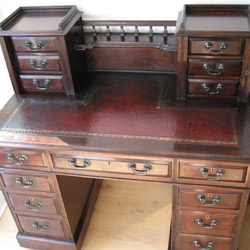 |
|
| William IV Wine Table |
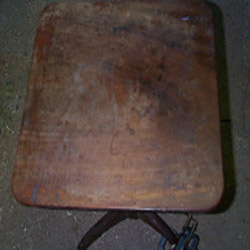 |
| This
pretty wine table had leg damage and as you can
see the one plank top needed french polishing. |
|
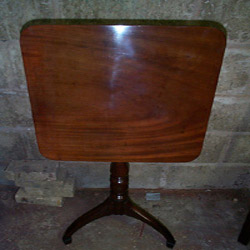 |
|
|
|
|
| Collections management and in-situ
projects for Large Country and Town Houses |
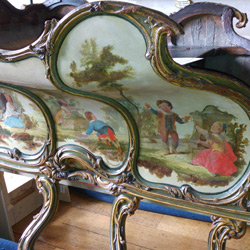 |
| This 18th
century Bavarian Sleigh required structural restoration but
could not be moved from its location. A bespoke stand was built
to allow repairs to the carved and gilded sleds |

|
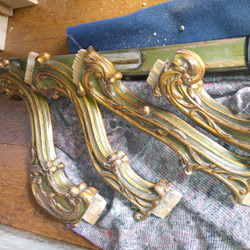 |
| |
|
|
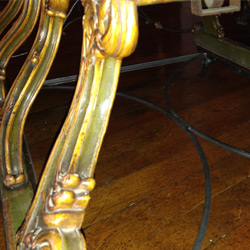 |
After restoration
an iron and mahogany transport carriage was fabricated with
rubber lockable wheels to allow the sleigh to be moved around
without causing damage to the delicate parts of the object.
We can undertake many projects in-situ if required or if
it is in best interests of the object. |

|
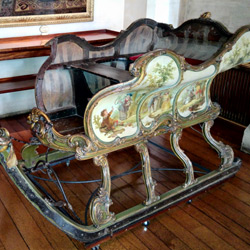 |
| |
|
|
| Reconstruction of an 18th century
Pole Lathe method of producing twist turnings |
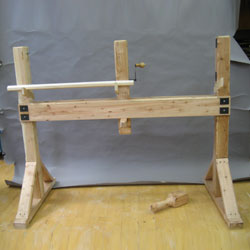 |
| After research
a pole lathe was built from seasoned larch, this example capable
of centre and bowl turning. After some practice to master the
basics I was ready to produce a twist. |

|
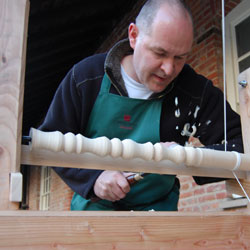 |
| |
|
|
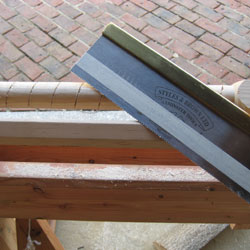 |
| After marking
out the pitch in the 18th century manner a saw cut provided
the basis for roughing out the twist with gouges. |

|
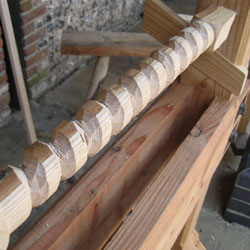 |
| |
|
|
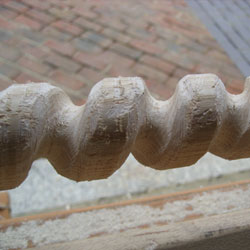 |
Then came
the coarse medium and fine rasps, followed by coarse medium
and fine files.
The final sanding was done using sharkskin and the twists
burnished with shavings to complete the finish. |

|
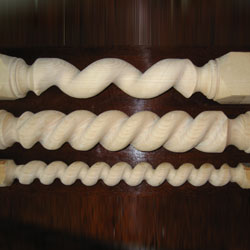 |
|
| Casting of brass components |
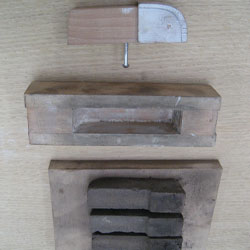 |
To reproduce
a specific brass casting one option available is sand casting.
A wooden "plug" is made along with a mold to cast
a "core" from sand - excluding the melt from the
negative space. |

|
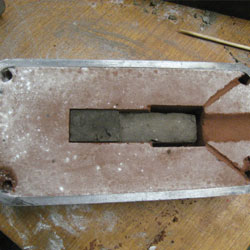 |
| |
|
|
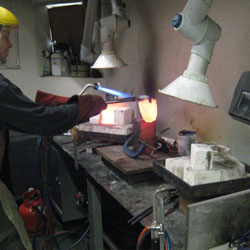 |
The brass
is heated in a crucible along with borax to inhibit oxidation
during the pour. The casing can be seen on the right before
removal of excess material. |

|
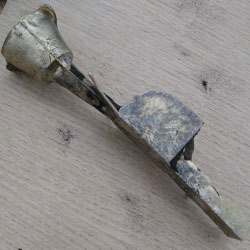 |
| |
|
|
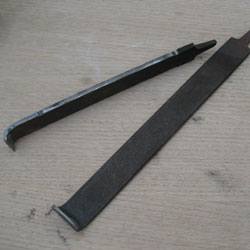 |
After removal
and shaping, files were softened - shaped and re-tempered
into scrapers to produce an authentic finish and witness toolmarks.
The process is repeated for all components - the finished
castor (1 of 4) can be seen on the right |

|
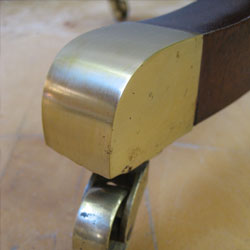 |
|
|
|
| |
|
|
| |
|
|
 |
|
|



































































































































